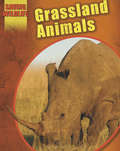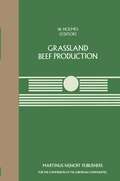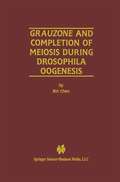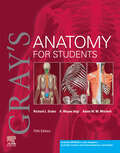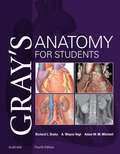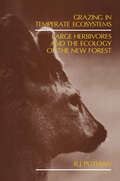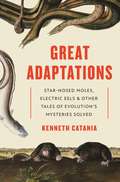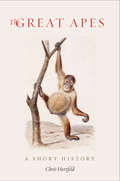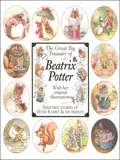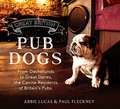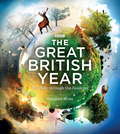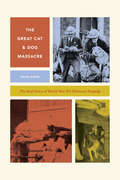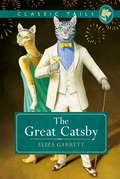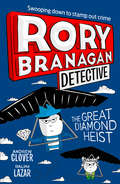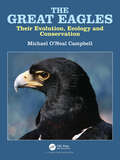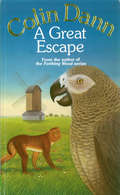- Table View
- List View
Grassland Animals (Saving Wildlife)
by Sonya NewlandGrassland Animals looks at the effects of human habitation and hunting on creatures of the world's savannahs and prairies -- from the planet's greatest predators to insects in the grass.It is part of the Saving Wildlife series, which investigates the world's endangered species in the context of their different environments.
Grassland Beef Production: A Seminar in the CEC Programme of Coordination of Research on Beef Production, held at the Centre for European Agricultural Studies, Wye College (University of London), Ashford, Kent, UK, July 25–27, 1983 (Current Topics in Veterinary Medicine #28)
by W. HolmesGrauzone and Completion of Meiosis During Drosophila Oogenesis
by Bin ChenGrauzone and Completion of Meiosis During Drosophila Oogenesis describes the work behind a major, award winning discovery: the establishment of a new pathway that specifically regulates the female meiosis, a process essential for sexual reproduction. This book chronicles a new gene mapping method and the cloning and documentation of several types of genes that were proven to have significant influence on the cell cycle. It is of interest to anyone doing work with fruit flies, both graduate students and principal investigators.
Gray's Anatomy for Students E-Book: Gray's Anatomy for Students E-Book (Gray's Anatomy)
by Richard L. Drake A. Wayne Vogl Adam W.M. MitchellConcise, readable text and an outstanding art program make Gray's Anatomy for Students, 5th Edition, your go-to text for essential information in human anatomy. This fully revised volume focuses on the core information medical students need to know, in an easy-access format and with additional multimedia content to facilitate effective study and mastery of the material. A team of expert authors share a wealth of diverse teaching and clinical experience—all enhanced by more than 1,000 innovative, original illustrations by renowned illustrators Richard Tibbitts and Paul Richardson, who capture anatomical features with unrivalled clarity. Helps you understand the practical applications of anatomical concepts through unique coverage of surface anatomy, correlative diagnostic images, and clinical case studies. Contains increased representation of diverse population groups throughout, incorporating a wider range of skin tones and important clinical considerations related to transgender and intersex individuals. Presents anatomy logically by body region – as well as bonus updated eBook chapters for each major body system to facilitate learning from a different perspective. Includes new and improved online materials such as self-assessment questions, medical and physical therapy clinical cases, a unique Interactive Surface Anatomy tool, and more. Provides fully revised and updated clinical content including numerous new In the Clinic boxes, images, and correlates throughout that reflect the latest advances seen in clinical practice. New and updated Clinical Cases are included in the accompanying enhanced eBook. Features an updated neuroanatomy eBook chapter, so you can learn key aspects of this challenging topic in the context of general anatomy. Improves comprehension of complex cranial nerves with a visual map summarizing cranial nerve distribution and function. Offers schematic drawings for key structures and topics in every chapter, providing an additional, simplified approach to introduce each topic—ideal for quick initial understanding and as a guide for your own anatomy drawings. Enables you to quickly review the basic concepts from each chapter with Conceptual Overviews. Evolve Instructor site with a downloadable image bank is available to instructors through their Elsevier sales rep or via request at https://evolve.elsevier.com.
Gray's Anatomy for Students E-Book: With Student Consult Online Access (Gray's Anatomy Ser.)
by Richard Drake A. Wayne Vogl Adam W. MitchellEasy to read, superbly illustrated, and clinically relevant, Gray’s Anatomy for Students, 4th Edition, is medical students’ go-to text for essential information in human anatomy. This fully revised volume focuses on the core information students need to know, in an easy-access format and with additional multimedia tools that facilitate effective study and mastery of the material. A team of expert authors and global advisors share their extensive teaching and clinical experience, highlighted by more than 1,000 innovative, original illustrations throughout the text.Helps students understand the practical applications of anatomical concepts through unique coverage of surface anatomy, correlative diagnostic images, and clinical case studies. Presents anatomy logically by body region, and now offers bonus eBook chapters for each major body system to facilitate learning from a different perspective – covering the Cardiovascular System, Respiratory System, Gastrointestinal System, Urogenital System, Lymphatic System, and Nervous System.Features an all-new eBook chapter covering the essentials of neuroanatomy, so readers can learn key aspects of this challenging topic in the context of general anatomy.Offers new schematic drawings for key structures and topics in every chapter, providing an additional, simplified approach to introduce each topic—ideal for quick initial understanding and as a guide for students’ own anatomy drawings. Includes new and improved online materials such as self-assessment questions, clinical cases, an Interactive Surface Anatomy tool, an online anatomy and embryology self-study course, and more.Provides fully revised and updated clinical content including numerous new In the Clinic boxes, plus new clinical cases, images, and correlates throughout.Enables readers to quickly review the basic concepts from each chapter with Conceptual Overviews.Evolve Instructor site with a downloadable image bank is available to instructors through their Elsevier sales rep or via request at: https://evolve.elsevier.com
Grazing in Temperate Ecosystems: Large Herbivores and the Ecology of the New Forest
by R.J. PutmanThe New Forest in southern England is an area of mixed vegetation set aside as a Royal Hunting Forest in the eleventh century and since that time subjected to heavy grazing pressure from large herbivores. The entire structure of the Forest and its various communities has been developed under this continued history ofheavy grazing, with the estab lishment of a series of vegetational systems unique within the whole of Europe. The effects of large herbivores in the structuring of this eco system in the past, and the pressure of grazing continuing to this day, have in turn a profound influence, indeed the dominating influence, on the whole ecological functioning of the Forest system. Because of its assemblage of unique vegetation types, the area is clearly of tremendous ecological interest in its own right. In addition, its long history of heavy grazing ani the continued intense herbivore pressure make the New Forest an ideal study-site for evaluation of both short-term and long term effects of grazing upon temperate ecosystems. The N ew Forest (some 37,500 ha in total area) currently supports a population of approximately 2,500 wild deer (red, roe, sika and fallow); in addition 3,500 ponies and 2,000 domestic cattle are pastured on the Forest under Common Rights.
Great Adaptations: Star-Nosed Moles, Electric Eels, and Other Tales of Evolution’s Mysteries Solved
by Kenneth CataniaHow one scientist unlocked the secrets behind some of nature’s most astounding animalsFrom star-nosed moles that have super-sensing snouts to electric eels that paralyze their prey, animals possess unique and extraordinary abilities. In Great Adaptations, Kenneth Catania presents an entertaining and engaging look at some of nature’s most remarkable creatures. Telling the story of his biological detective work, Catania sheds light on the mysteries behind the behaviors of tentacled snakes, tiny shrews, zombie-making wasps, and more. He shows not only how studying these animals can provide deep insights into how life evolved, but also how scientific discovery can be filled with adventure and fun.Beginning with the star-nosed mole, Catania reveals what the creature’s nasal star is actually for, and what this tells us about how brains work. He explores how the deceptive hunting strategy of tentacled snakes leads prey straight to their mouths, how eels use electricity to control other animals, and why emerald jewel wasps make zombies out of cockroaches. He also solves the enigma of worm grunting—a traditional technique in which earthworms are enticed out of the ground—by teaming up with professional worm grunters. Catania demonstrates the merits of approaching science with an open mind, considers the role played by citizen scientists, and illustrates that most animals have incredible, hidden abilities that defy our imagination.Examining some strange and spectacular creatures, Great Adaptations offers a wondrous journey into nature’s grand designs.
The Great Apes: A Short History
by Chris HerzfeldA unique, beautifully illustrated exploration of our fascination with our closest primate relatives, and the development of primatology as a discipline This insightful work is a compact but wide-ranging survey of humankind’s relationship to the great apes (chimpanzees, bonobos, gorillas, orangutans), from antiquity to the present. Replete with fascinating historical details and anecdotes, it traces twists and turns in our construction of primate knowledge over five hundred years. Chris Herzfeld outlines the development of primatology and its key players and events, including well-known long-term field studies, notably the pioneering work by women such as Jane Goodall, Dian Fossey, and Biruté Galdikas. Herzfeld seeks to heighten our understanding of great apes and the many ways they are like us. The reader will encounter apes living in human families, painting apes, apes who use American Sign Language, and chimpanzees who travelled in space. A philosopher and historian specializing in primatology, Herzfeld offers thought-provoking insights about our perceptions of apes, as well as the boundary between “human” and “ape” and what it means to be either.
Great British Pub Dogs: From Dachshunds to Great Danes, the Canine Residents of Britain’s Pubs
by Abbie Lucas Paul Fleckney'Sheer, magnificent pointlessness' Marcus Berkmann, Spectator gift guideReader reviews: 'The perfect stocking filler for fans of our four-legged friends and great British pubs alike' - Richard Attwood'Bought one copy for myself and now I have come back another three times to buy it as presents for other people.' - Chris Moon'A perfect Christmas present!''Glorious photos and some very funny commentary''What an awesome collection of pub dogs''Beautiful pictures of a range of public house pooches the length and breadth of Britain' - Carl Morris'A beautifully crafted book giving a perfect insight into British culture' - Jill Monum'Great book, well thought out and beautifully produced'This beautifully photographed collection tells the stories of the much-loved dogs, of all kinds, that live in pubs all over Great Britain, not least the Pub Dog Capital of Britain, Whitstable. Locals love their pub dogs and landlords often say that people come in as much for the dog as for anything else. Dogs make a pub feel like home for regulars.Fleckney and Lucas chronicle the incredible variety of dogs that actually live in, rather than simply visit, Britain's pubs. They showcase the dogs with their beautiful photographic portraits and tell their stories, too. In feel, this is very much a 'family album' of British pub dogs.
The Great British Year: Wildlife through the Seasons
by Stephen MossBritain is a place of remarkable beauty and extraordinary extremes, boasting immense natural diversity in a comparatively small area. Here, life is run by the seasons: each month brings enormous transformations to our island and its inhabitants, from the largest native mammal to the smallest migrant bird. In this lavish companion to the unforgettable BBC One series, acclaimed nature writer Stephen Moss reveals a breathtaking view of the wildlife on our very own doorstep, complete with stunning photography, innovative maps and unique behind-the-scenes materialfrom the award-winning BBC Natural History Unit. Britain's wildlife is at once iconic and surprising, and this book celebrates it all in the light of our ever-changing seasons. From the clash of majestic stags to the emergence of delicate damselflies; and from the sharks and whales that swim our waters to the elegant and imposing birds in our skies, The Great British Year reveals the unmissable drama and beauty of our islands.
The Great Cat and Dog Massacre: The Real Story of World War Two's Unknown Tragedy (Animal Lives)
by Hilda KeanThe tragedies of World War II are well known. But at least one has been forgotten: in September 1939, four hundred thousand cats and dogs were massacred in Britain. The government, vets, and animal charities all advised against this killing. So why would thousands of British citizens line up to voluntarily euthanize household pets? In The Great Cat and Dog Massacre, Hilda Kean unearths the history, piecing together the compelling story of the life—and death—of Britain’s wartime animal companions. She explains that fear of imminent Nazi bombing and the desire to do something to prepare for war led Britons to sew blackout curtains, dig up flower beds for vegetable patches, send their children away to the countryside—and kill the family pet, in theory sparing them the suffering of a bombing raid. Kean’s narrative is gripping, unfolding through stories of shared experiences of bombing, food restrictions, sheltering, and mutual support. Soon pets became key to the war effort, providing emotional assistance and helping people to survive—a contribution for which the animals gained government recognition. Drawing extensively on new research from animal charities, state archives, diaries, and family stories, Kean does more than tell a virtually forgotten story. She complicates our understanding of World War II as a “good war” fought by a nation of “good” people. Accessibly written and generously illustrated, Kean’s account of this forgotten aspect of British history moves animals to center stage—forcing us to rethink our assumptions about ourselves and the animals with whom we share our homes.
The Great Cat and Dog Massacre: The Real Story of World War Two's Unknown Tragedy (Animal Lives)
by Hilda KeanThe tragedies of World War II are well known. But at least one has been forgotten: in September 1939, four hundred thousand cats and dogs were massacred in Britain. The government, vets, and animal charities all advised against this killing. So why would thousands of British citizens line up to voluntarily euthanize household pets? In The Great Cat and Dog Massacre, Hilda Kean unearths the history, piecing together the compelling story of the life—and death—of Britain’s wartime animal companions. She explains that fear of imminent Nazi bombing and the desire to do something to prepare for war led Britons to sew blackout curtains, dig up flower beds for vegetable patches, send their children away to the countryside—and kill the family pet, in theory sparing them the suffering of a bombing raid. Kean’s narrative is gripping, unfolding through stories of shared experiences of bombing, food restrictions, sheltering, and mutual support. Soon pets became key to the war effort, providing emotional assistance and helping people to survive—a contribution for which the animals gained government recognition. Drawing extensively on new research from animal charities, state archives, diaries, and family stories, Kean does more than tell a virtually forgotten story. She complicates our understanding of World War II as a “good war” fought by a nation of “good” people. Accessibly written and generously illustrated, Kean’s account of this forgotten aspect of British history moves animals to center stage—forcing us to rethink our assumptions about ourselves and the animals with whom we share our homes.
The Great Cat and Dog Massacre: The Real Story of World War Two's Unknown Tragedy (Animal Lives)
by Hilda KeanThe tragedies of World War II are well known. But at least one has been forgotten: in September 1939, four hundred thousand cats and dogs were massacred in Britain. The government, vets, and animal charities all advised against this killing. So why would thousands of British citizens line up to voluntarily euthanize household pets? In The Great Cat and Dog Massacre, Hilda Kean unearths the history, piecing together the compelling story of the life—and death—of Britain’s wartime animal companions. She explains that fear of imminent Nazi bombing and the desire to do something to prepare for war led Britons to sew blackout curtains, dig up flower beds for vegetable patches, send their children away to the countryside—and kill the family pet, in theory sparing them the suffering of a bombing raid. Kean’s narrative is gripping, unfolding through stories of shared experiences of bombing, food restrictions, sheltering, and mutual support. Soon pets became key to the war effort, providing emotional assistance and helping people to survive—a contribution for which the animals gained government recognition. Drawing extensively on new research from animal charities, state archives, diaries, and family stories, Kean does more than tell a virtually forgotten story. She complicates our understanding of World War II as a “good war” fought by a nation of “good” people. Accessibly written and generously illustrated, Kean’s account of this forgotten aspect of British history moves animals to center stage—forcing us to rethink our assumptions about ourselves and the animals with whom we share our homes.
The Great Cat and Dog Massacre: The Real Story of World War Two's Unknown Tragedy (Animal Lives)
by Hilda KeanThe tragedies of World War II are well known. But at least one has been forgotten: in September 1939, four hundred thousand cats and dogs were massacred in Britain. The government, vets, and animal charities all advised against this killing. So why would thousands of British citizens line up to voluntarily euthanize household pets? In The Great Cat and Dog Massacre, Hilda Kean unearths the history, piecing together the compelling story of the life—and death—of Britain’s wartime animal companions. She explains that fear of imminent Nazi bombing and the desire to do something to prepare for war led Britons to sew blackout curtains, dig up flower beds for vegetable patches, send their children away to the countryside—and kill the family pet, in theory sparing them the suffering of a bombing raid. Kean’s narrative is gripping, unfolding through stories of shared experiences of bombing, food restrictions, sheltering, and mutual support. Soon pets became key to the war effort, providing emotional assistance and helping people to survive—a contribution for which the animals gained government recognition. Drawing extensively on new research from animal charities, state archives, diaries, and family stories, Kean does more than tell a virtually forgotten story. She complicates our understanding of World War II as a “good war” fought by a nation of “good” people. Accessibly written and generously illustrated, Kean’s account of this forgotten aspect of British history moves animals to center stage—forcing us to rethink our assumptions about ourselves and the animals with whom we share our homes.
The Great Cat and Dog Massacre: The Real Story of World War Two's Unknown Tragedy (Animal Lives)
by Hilda KeanThe tragedies of World War II are well known. But at least one has been forgotten: in September 1939, four hundred thousand cats and dogs were massacred in Britain. The government, vets, and animal charities all advised against this killing. So why would thousands of British citizens line up to voluntarily euthanize household pets? In The Great Cat and Dog Massacre, Hilda Kean unearths the history, piecing together the compelling story of the life—and death—of Britain’s wartime animal companions. She explains that fear of imminent Nazi bombing and the desire to do something to prepare for war led Britons to sew blackout curtains, dig up flower beds for vegetable patches, send their children away to the countryside—and kill the family pet, in theory sparing them the suffering of a bombing raid. Kean’s narrative is gripping, unfolding through stories of shared experiences of bombing, food restrictions, sheltering, and mutual support. Soon pets became key to the war effort, providing emotional assistance and helping people to survive—a contribution for which the animals gained government recognition. Drawing extensively on new research from animal charities, state archives, diaries, and family stories, Kean does more than tell a virtually forgotten story. She complicates our understanding of World War II as a “good war” fought by a nation of “good” people. Accessibly written and generously illustrated, Kean’s account of this forgotten aspect of British history moves animals to center stage—forcing us to rethink our assumptions about ourselves and the animals with whom we share our homes.
The Great Cat and Dog Massacre: The Real Story of World War Two's Unknown Tragedy (Animal Lives)
by Hilda KeanThe tragedies of World War II are well known. But at least one has been forgotten: in September 1939, four hundred thousand cats and dogs were massacred in Britain. The government, vets, and animal charities all advised against this killing. So why would thousands of British citizens line up to voluntarily euthanize household pets? In The Great Cat and Dog Massacre, Hilda Kean unearths the history, piecing together the compelling story of the life—and death—of Britain’s wartime animal companions. She explains that fear of imminent Nazi bombing and the desire to do something to prepare for war led Britons to sew blackout curtains, dig up flower beds for vegetable patches, send their children away to the countryside—and kill the family pet, in theory sparing them the suffering of a bombing raid. Kean’s narrative is gripping, unfolding through stories of shared experiences of bombing, food restrictions, sheltering, and mutual support. Soon pets became key to the war effort, providing emotional assistance and helping people to survive—a contribution for which the animals gained government recognition. Drawing extensively on new research from animal charities, state archives, diaries, and family stories, Kean does more than tell a virtually forgotten story. She complicates our understanding of World War II as a “good war” fought by a nation of “good” people. Accessibly written and generously illustrated, Kean’s account of this forgotten aspect of British history moves animals to center stage—forcing us to rethink our assumptions about ourselves and the animals with whom we share our homes.
The Great Catsby: Beautifully illustrated classics, as told by the finest breeds! (Classic Tails)
by Eliza GarrettCLASSIC TAILS - the greatest works of literature, as told by the finest breedsWe all have our favourite classic tales; books that have been beloved to us since childhood, whose wonderful stories and rich tapestry of characters are unsurpassed in modern literature. How, you may ask, could these marvellous works ever be improved upon?Reader, ask no more...for we present The Great CatsbyMillionaire Jay Catsby is a mystery. All alone in his moggy mansion, he throws extravagant parties attended by all the great and the good of the feline world. What nobody knows is that this is a kitty haunted by love - the love of a beautiful pussycat called Daisy, whom he lost to another long ago - and Catsby's great wish is that one day she, too, might be drawn to join the festivities.When Daisy's cousin Nick moves in next door, it seems like Catsby is a whisker away from winning back his beloved. But Daisy's husband Tomcat has other ideas...What readers are saying about The Great Catsby:'Hilarious twist on a classic, filled with many much appreciated cat puns''A lovely feline version of the classic tale. Beautiful and cute images and a lot of funny cat references!''Fun book - cleverly written. 5 stars'
Great Crested Newt (Large Print)
This is a picture of a Great Crested Newt viewed from the side and facing to the left. There is a locator dot shown, which will be at the top left of the page when the image is the right way up. On the far left is the newt's head with its mouth and one eye visible. The newt's body is to the right with a crest running along the top to the tail at the far right. The newt's legs can be found down from its body towards the bottom of the page. The two front legs, on the left, have four toes, while the back legs, on the right, have five. There are dark patches all over the newt's body and legs.
Great Crested Newt (UEB Contracted)
This is a picture of a Great Crested Newt viewed from the side and facing to the left. There is a locator dot shown, which will be at the top left of the page when the image is the right way up. On the far left is the newt's head with its mouth and one eye visible. The newt's body is to the right with a crest running along the top to the tail at the far right. The newt's legs can be found down from its body towards the bottom of the page. The two front legs, on the left, have four toes, while the back legs, on the right, have five. There are dark patches all over the newt's body and legs.
Great Crested Newt (UEB uncontracted)
This is a picture of a Great Crested Newt viewed from the side and facing to the left. There is a locator dot shown, which will be at the top left of the page when the image is the right way up. On the far left is the newt's head with its mouth and one eye visible. The newt's body is to the right with a crest running along the top to the tail at the far right. The newt's legs can be found down from its body towards the bottom of the page. The two front legs, on the left, have four toes, while the back legs, on the right, have five. There are dark patches all over the newt's body and legs.
The Great Diamond Heist (Rory Branagan (Detective) #7)
by Andrew CloverHello. I am Rory Branagan. I am a DETECTIVE, and the time has come for me to solve the BIGGEST and most IMPORTANT mystery in my life: where is my Dad?
The Great Eagles: Their Evolution, Ecology and Conservation
by Michael O'Neal CampbellThis book examines the current literature and knowledge on the evolution and ecology of all the birds named as eagles, with particular emphasis on the larger species. It also examines the past and current relations between eagles and people, including habitat change and conservation issues. Eagle ecologies and conservation are currently seriously impacted by human activities such as industrialization, urbanization, pollution, deforestation and hunting. Some eagle species have consequently experienced extreme population changes. There are, however, some positive developments. Eagles have a strong, historic bond with human civilization, due to their status as the world’s most charismatic birds. Conservation policies have also been successful in repopulating some ecosystems with breeding eagles. Therefore, despite the complexity of this relationship, there may yet be hope for this unique species group, frequently rated as the kings of birds, and symbolic of human power, ambition, royalty, nationality, and even concepts of God. It is hoped that this book will contribute to the further understanding of these unique and fantastic birds.
The Great Eagles: Their Evolution, Ecology and Conservation
by Michael O'Neal CampbellThis book examines the current literature and knowledge on the evolution and ecology of all the birds named as eagles, with particular emphasis on the larger species. It also examines the past and current relations between eagles and people, including habitat change and conservation issues. Eagle ecologies and conservation are currently seriously impacted by human activities such as industrialization, urbanization, pollution, deforestation and hunting. Some eagle species have consequently experienced extreme population changes. There are, however, some positive developments. Eagles have a strong, historic bond with human civilization, due to their status as the world’s most charismatic birds. Conservation policies have also been successful in repopulating some ecosystems with breeding eagles. Therefore, despite the complexity of this relationship, there may yet be hope for this unique species group, frequently rated as the kings of birds, and symbolic of human power, ambition, royalty, nationality, and even concepts of God. It is hoped that this book will contribute to the further understanding of these unique and fantastic birds.
A Great Escape
by Colin DannEric made up his mind. He would go to the pet shop, open the cages and let the little troupe of animals free, to make their own way in the world. And so began A Great Escape.
